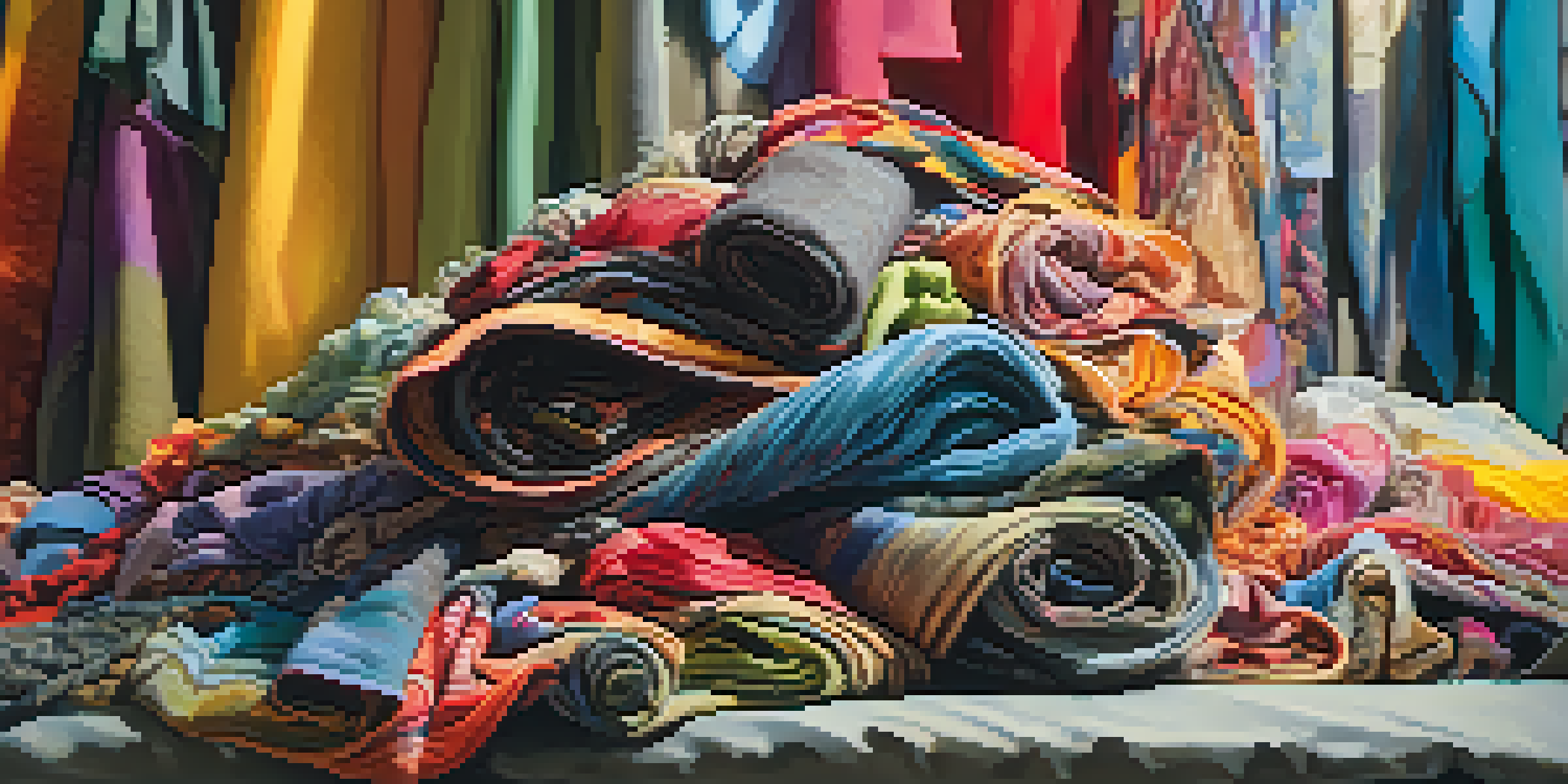The Role of Textile Waste in Climate Change and Solutions

Textile Waste: A Growing Environmental Concern
Textile waste has become a significant environmental issue, contributing to global pollution. With fast fashion trends, consumers often discard clothes after a few wears, leading to mountains of textile waste. According to recent studies, the fashion industry is responsible for about 10% of global carbon emissions, which is staggering when you think about it.
The greatest threat to our planet is the belief that someone else will save it.
In many countries, discarded clothing ends up in landfills, where it can take decades to decompose. This process releases harmful greenhouse gases like methane, further worsening climate change. Additionally, the dyes and chemicals used in fabric production can leach into the soil and water, causing further environmental damage.
As awareness grows about the impact of textile waste, many are questioning the sustainability of their clothing choices. Understanding this issue is crucial, as it connects our everyday decisions to broader environmental consequences.
The Lifecycle of Textile Products and Their Impact
Every piece of clothing has a lifecycle, starting from raw material extraction to production, distribution, use, and finally, disposal. Each stage contributes to environmental degradation, particularly in terms of energy consumption and waste generation. For instance, cotton farming requires significant water resources, while synthetic fibers are derived from petroleum, which is not only finite but also polluting.

During the production phase, the process often involves toxic chemicals that can harm both workers and the environment. Once the garment reaches consumers, its impact continues as washing and drying contribute to microplastic pollution in oceans. These microplastics can harm marine life and even enter our food chain, showcasing how interconnected our actions are.
Textile Waste: A Global Crisis
The fashion industry significantly contributes to global pollution, generating massive amounts of textile waste that harms the environment.
Recognizing the lifecycle of textiles helps consumers understand the importance of making informed choices. By considering where and how our clothes are made, we can start to shift the narrative around textile waste.
The Role of Consumer Behavior in Textile Waste
Consumer behavior plays a pivotal role in the textile waste crisis. The rise of fast fashion has led many to prioritize low-cost, trendy items over sustainability. This mindset fuels a cycle of overconsumption, where clothes are often worn only a few times before being discarded, creating a disposable culture.
We don't need a handful of people doing zero waste perfectly. We need millions of people doing it imperfectly.
Additionally, many consumers are unaware of the environmental implications of their purchases. A lack of education around sustainable practices can lead to choices that harm the planet. However, when consumers are informed, they can become powerful advocates for change, opting for brands that prioritize eco-friendly practices.
By making conscious choices—like buying second-hand, investing in quality pieces, or supporting sustainable brands—consumers can significantly reduce textile waste. These small changes can collectively lead to a more sustainable fashion industry.
Innovative Solutions to Combat Textile Waste
Fortunately, there are innovative solutions emerging to tackle the issue of textile waste. One approach is the rise of circular fashion, which focuses on designing clothes that can be reused, repaired, or recycled. Brands are increasingly adopting sustainable materials and processes, reducing their overall environmental footprint.
Another solution is the promotion of textile recycling programs. Many organizations now offer clothing collection services, where old garments can be repurposed or recycled into new products. This not only diverts waste from landfills but also encourages a culture of sustainability among consumers.
Consumer Choices Matter
Informed consumer behavior can drive change, encouraging sustainable practices and reducing textile waste through mindful purchasing.
Furthermore, technology is playing a significant role in these solutions. Innovations like fabric recycling methods and apps that facilitate clothing swaps are gaining traction, demonstrating that the fashion industry can evolve towards more sustainable practices.
Government Regulations and Policies on Textile Waste
Government regulations can significantly influence how the fashion industry manages textile waste. Many countries are beginning to implement policies that require brands to take responsibility for their products throughout their lifecycle. This includes mandates for recycling programs and sustainable production practices.
For example, some nations have introduced extended producer responsibility (EPR) laws, which hold manufacturers accountable for the disposal of their products. Such regulations encourage brands to design for longevity and recyclability, shifting the focus from short-term profits to long-term sustainability.
As governments continue to recognize the urgency of climate change, these policies are likely to expand, fostering a more responsible fashion industry. Collective action from consumers and regulations can drive meaningful change in how we approach textile waste.
The Importance of Education and Awareness
Education and awareness are vital components in the fight against textile waste. By informing consumers about the environmental impacts of their clothing choices, we can encourage more sustainable behavior. Schools, community organizations, and brands can play a role in spreading this knowledge.
Workshops and campaigns focused on sustainable fashion can empower individuals to make informed decisions. For instance, learning how to repair a garment instead of tossing it can extend its life and reduce waste. These initiatives can also highlight the benefits of second-hand shopping and sustainable brands.
Innovative Solutions Emerge
Circular fashion and recycling initiatives are innovative strategies that can help mitigate the impact of textile waste on the planet.
Ultimately, when consumers are equipped with knowledge, they can influence the market by demanding more sustainable options. This shift in mindset can create a ripple effect, prompting brands to adapt and prioritize eco-friendly practices.
The Future of Fashion: A Sustainable Approach
Looking ahead, the future of fashion must embrace sustainability to combat the textile waste crisis. This means rethinking how clothes are produced, consumed, and disposed of. The industry is at a crossroads, where the choices made today will shape its environmental impact for generations to come.
Sustainable fashion isn't just about eco-friendly materials; it's about a holistic approach that includes ethical labor practices, transparency, and consumer education. Brands that prioritize these elements will not only help the planet but also resonate with a growing demographic of conscious consumers.

As we move forward, it's essential for all stakeholders—consumers, brands, and governments—to collaborate and innovate. Together, we can create a fashion industry that respects the environment and promotes a more sustainable future.